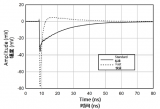這篇文章來源于DevicePlus.com英語網站的翻譯稿。
點擊此處跳轉至本文第一部分 >

這是CMUcam5 Pixy簡介的第二部分。如果您對PixyMon不太熟悉,請先回顧 CMUcam5 Pixy視覺相機傳感器簡介。在第一部分中,我介紹了Pixy的基礎知識,解釋了hello_world代碼,并創建了一個簡單的伺服驅動的應用程序。在本教程中,我將進一步探索Pixy的應用,創建一個球平衡梁。通過一個伺服來設置平衡梁的角度,使球停留在中間,當然,Pixy相機傳感器會對球進行追蹤。
硬件
Arduino Uno (您可以使用任何 Arduino)
CMUcam5 Pixy 相機
伺服電機 (S06NF)
木片和螺絲
數據線(用于相機USB MINI 以及Uno USB B)
用于伺服的5V外部電源(!警告!如果您將伺服連接到Arduino通過USB進行供電,您的Arduino將會被燒壞)
軟件
Arduino IDE 1.6.9
PixyMon 軟件 (https://cmucam.org/projects/cmucam5/wiki/Install_PixyMon_on_Windows_Vista_7_8)
PixyMon 用于 Arduino 的庫(https://cmucam.org/projects/cmucam5/wiki/Latest_release)
Processing 3.1.1 (https://processing.org/download/?processing)
Processing的簡單介紹

Processing是非常有用又靈活的一款軟件。它主要用于視覺藝術和科技領域的視覺語言。這款軟件具有100多個庫,可支持各種項目。它的文檔非常齊全,提供了許多使用指南,涵蓋了從編程基礎到可視化等各種主題。它能夠支持所有操作系統(GNU/Linux, Mac OS X, 和 Windows)。該軟件的設計幾乎和Arduino IDE相同。
今天,我們將使用Processing,通過串行通信實現與Arduino之間的通信。

圖1:Processing界面
項目概況
在此項目中,我將制作一個球平衡梁,一個用木頭制成的“通道”將會像一桿秤那樣使球保持平衡(圖2)。平衡梁44cm寬,3cm高。我把它制造的像通道一樣狹窄,使我們所追蹤的球不會掉落出去。
我使用S06NF伺服電機來移動整個平衡梁,該電機由Arduino進行控制。之后我們會看一下在本教程后面部分的代碼。現在,我已經將伺服放置在了距離平衡梁左端?的位置。

圖2:S06NF STD 伺服電機/ ?RobotShop inc.
伺服將上下移動平衡梁,同時,球也會沿著該路徑移動。

圖3:平衡梁上下移動
數碼相機將會放置在平衡梁上。我將相機的視野范圍設置為僅限于平衡梁。這樣,相機就會只追蹤球,不追蹤任何其他物體了。
平衡梁結構
首先,我們需要一些用于構建平衡梁的材料。我將要使用的是一種簡單的XXMM木材(20cm x 27cm)。我用圓鋸來切割木材,但是您可以使用現有的任何類型的鋸來完成切割,只要能夠保障切割面平整、均勻即可。

圖4:XXMM木材
請記住,只有使用正確的工具才能夠制造出完美的平衡梁!我使用的是一把錘子、一把直尺、釘子、砂紙、熱膠、一個鉆頭和一把鋸子。

圖5:工具
首先,我將制造一個通道,使球能夠在其中左右移動。通道的側面由四塊木板組成(每個21cm x 3cm)。通道在高度方向的兩端將由兩塊木板(4cm x 3cm)封接。底座的尺寸是42cm x 3cm x 1cm。
我使用15mm大帽釘來連接零部件。

圖6:封閉通道
在通道中間建立傾斜點有很多種方法。我使用了一種非常簡單的方法,因為成本最低且最容易實現。我用了一個長釘子,兩個像軸承一樣的小管子,先標記了通道的中心點,然后將這些小軸承熱粘合到該中心點,再插入釘子。

圖7:用于構建傾斜點的釘子和管子
為了設置傾斜點,我們還需要為釘子制作支架。我用了兩塊8cm x 2cm的木板,如圖8所示。我還制作了一個小平臺,可以將所有東西放置在一起,尺寸為12cm x 4.5cm。

圖8:傾斜點支架
我使用了一小塊木材來安裝伺服并將其架起。

圖9:安裝在木板上的伺服
在本教程中我使用的是Arduino UNO,但是您也可以使用其他具有SPI連接器的Arduino來連接到Pixy相機。
連接所有部件
一旦構建完成,下一步就是將Pixy相機連接到Arduino,然后再連接到伺服。原理圖與 CMUcam5 Pixy視覺相機傳感器簡介中的相同。我仍然使用外部5V電源為伺服供電。
!警告!不要忘記連接接地端。如果沒有將電源、伺服和Arduino接地端相連接,伺服將會失控!

圖10:接線圖
接下來,我需要在平衡梁結構上方的某個位置設置Pixy,以便它可以隨時檢測到球的位置。調整設置使其僅可以對球進行檢測。請參考第一部分進行設置。

圖11:Pixy視覺
現在,讓我們來看一些代碼。為了檢測伺服是否工作正常,我修改了中間、最右邊和最左邊的角度,使其適合于我的結構。
#include uint8_t leveled = 110; //middle positon for s1 to keep the board leveled uint8_t far_right = 180; //far left positon for s1 to keep the board leveled uint8_t far_left = 0; //far right positon for s1 to keep the board levele Servo s; void setup(){ s.write(leveled); delay(2000); s.write(far_right); delay(2000); s.write(far_left); delay(2000); } void loop(){ }
當然,您可以根據自己的喜好來調整變量。
之前,我介紹了一個名叫Processing的軟件。我將使用它通過串行通信來實現與Arduino的通信。
Arduino 代碼
簡單的串行通信:
#include
#include
char val; // Data received from the serial port
int ledPin = 13; // Set the pin to digital I/O 13
void setup() {
pinMode(ledPin, OUTPUT); // Set pin as OUTPUT
Serial.begin(9600); // Start serial communication at 9600 bps
}
void loop() {
if (Serial.available())
{ // If data is available to read,
val = Serial.read(); // read it and store it in val
}
if (val == '1')
{ // If 1 was received
digitalWrite(ledPin, HIGH); // turn the LED on
} else {
digitalWrite(ledPin, LOW); // otherwise turn it off
}
delay(10); // Wait 10 milliseconds for next reading
}
Processing 代碼
import processing.serial.*;
Serial myPort; // Create object from Serial class
void setup()
{
size(200,200); //make our canvas 200 x 200 pixels big
String portName = Serial.list()[0]; //change the 0 to a 1 or 2 etc. to match your port
myPort = new Serial(this, portName, 9600);
}
void draw() {
if (mousePressed == true)
{ //if we clicked in the window
myPort.write('1'); //send a 1
println("1");
} else
{ //otherwise
myPort.write('0'); //send a 0
}
}
改代碼創建了一個200×200像素的窗口并初始化串行端口。draw()空函數用于檢查是否在窗口上按下了鼠標(如果按下寫入1,沒有按下則寫入0)。
現在,我們來測試代碼。點擊運行,然后嘗試點擊窗口中任意位置,這時您的LED燈應發生閃爍,這就表示著一切工作正常!

圖12:Processing 和 Arduino代碼的基本測試
使用Processing編程
我獲取了伺服的相關值,并在Processing中對其進行了處理,所以產生了一個類似于下圖所示的圖片。

圖13:示例圖片
請用以下代碼創建圖像:
import processing.serial.*; Serial myPort; // The serial port int xPos = 1; // horizontal position of the graph float inByte = 0; void setup () { // set the window size: size(400, 300); // List all the available serial ports // if using Processing 2.1 or later, use Serial.printArray() println(Serial.list()); // I know that the first port in the serial list on my mac // is always my Arduino, so I open Serial.list()[0]. // Open whatever port is the one you're using. myPort = new Serial(this, Serial.list()[0], 9600); // don't generate a serialEvent() unless you get a newline character: myPort.bufferUntil('n'); // set inital background: background(0); } void draw () { // draw the line: stroke(127, 34, 255); line(xPos, height, xPos, height - inByte); // at the edge of the screen, go back to the beginning: if (xPos >= width) { xPos = 0; background(0); } else { // increment the horizontal position: xPos++; } } void serialEvent (Serial myPort) { // get the ASCII string: String inString = myPort.readStringUntil('n'); if (inString != null) { // trim off any whitespace: inString = trim(inString); // convert to an int and map to the screen height: inByte = float(inString); println(inByte); inByte = map(inByte, 0, 1023, 0, height); } }
Arduino 代碼:
#include
#include
#include
#include
//37 164 288
uint8_t leveled = 110; //middle positon for s1 to keep the board leveled
uint8_t far_right = 180; //far left positon for s1 to keep the board leveled
uint8_t far_left = 0; //far right positon for s1 to keep the board levele
int current_pos = leveled;
int percentage,var,_percen;
Servo s;
Pixy pixy;
void test_board(){
while(Serial.read() != 'b');
Serial.write("Starting test");
s.write(leveled);
delay(2000);
s.write(far_right);
delay(2000);
s.write(far_left);
delay(2000);
Serial.write("Finished test, press any key to continue");
while(Serial.read() != 'c');
s.write(current_pos);
Serial.write("Continued");
}
void setup() {
Serial.begin(9600);
s.attach(9);
pixy.init();
while (!Serial);
//test_board();
s.write(current_pos);
}
void _servo(unsigned char side,int var){
//by the % we get how "hard" we need to wip :D
var = var - 90;
if(side == 'L'){
//Serial.write("LEFT");
//90 180
_percen = 90 + var;
s.write(_percen);
}else{
//Serial.write("RIGHT");
//0 90
_percen = 90 - var;
s.write(_percen);
}
}
void loop() {
static int i = 0;
int j;
uint16_t blocks;
char buf[32];
// grab blocks!
blocks = pixy.getBlocks();
// If there are detect blocks, print them!
if (blocks)
{
i++;
// do this (print) every 50 frames because printing every
// frame would bog down the Arduino
if (i%1 ==0)
{
//sprintf(buf, "Detected %d:n", blocks);
//Serial.print(buf);
for (j=0; j= 0){
// Serial.write("LEFT");
var = percentage / 0.4;
_servo('L',var);
}else if(percentage >= 60 && percentage <= 110){
//Serial.write("RIGHT");
var = (percentage - 60) / 0.5;
_servo('R',var);
}else{
//Serial.write("MIDDLE");
}
}
}
}
}
代碼釋義
我將x的位置從Pixy轉換為0-100%,并由此了解球的具體位置。通過獲取球的位置,我可以調整伺服轉速。如果球的位置<=10%,伺服會轉得更快來維持平衡;如果在~40%附近,伺服會以很低的轉速來維持平衡。想要一直保持平衡是比較棘手的,我們可以改進算法以使其更加精確。
以下是一些有益于提升的建議:
? 嘗試多種算法
? 有多種類型的數學算法可以進行計算。我至少嘗試了兩到三種,但是最后決定選擇該算法。我建議您自己來編寫算法,以更好地掌握這種平衡的方法。
? 更好的硬件
? 對于本項目來說,沒有什么材料可稱得上是完美的,木材就更差得遠了。如果我擁有及時可用的資源,那我會選擇用金屬來建造它,這樣整個項目將會更加穩定和精確。
? 變得更快
? 我們如何做到使其更快地恢復平衡?我在這里使用了一個簡單的伺服。我們可以將其替換為UART或者AX-12之類的伺服,它們會強大、快速得多。速度也與算法有關。同樣,我建議您嘗試不同的算法,以找到適用于您的目的的算法。
有許多項目使用類似的概念來對平衡某物體。除了Pixy,您還可以將OpenCV與任何網絡相機一起使用來檢測目標和顏色。除了Processing,還有Max/MSP版本5。您可以使用距離傳感器、壓力傳感器等。因此,有多種方式可以幫助您對該項目進行提升,使其更加堅固、穩定和更快。
審核編輯黃宇
-
傳感器
+關注
關注
2552文章
51237瀏覽量
754782 -
Arduino
+關注
關注
188文章
6472瀏覽量
187355
發布評論請先 登錄
相關推薦
Sony偏振傳感器加持 Blackfly S工業相機突破視覺成像反光難題

視覺AI之旅:一起探索 FiftyOne ——第二部分 入門指南

松下MPS媒體制作平臺第七篇:視頻混合器插件(第二部分)

Air780EP硬件設計原理解析(第二部分)

0.4mm層疊封裝(PoP)封裝的PCB組裝指南,第二部分

精密制造的革新:光譜共焦傳感器與工業視覺相機的融合
求助,opa695的datesheet問題求解
使用rt_thread_mdelay函數后出現hardfault的原因?
美國商務部長呼吁推動第二部芯片法案,助力全球半導體主導地位
如何校準ph傳感器 pH傳感器的校準方法
TE Connectivity工業事業部推出1000V高壓傳感連接器,國產傳感器跨入1英寸時代





 CMUcam5 Pixy視覺相機傳感器簡介第二部分—創建球平衡梁
CMUcam5 Pixy視覺相機傳感器簡介第二部分—創建球平衡梁











評論